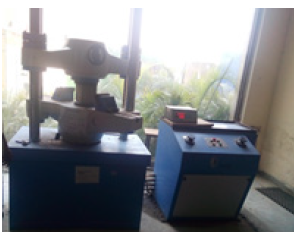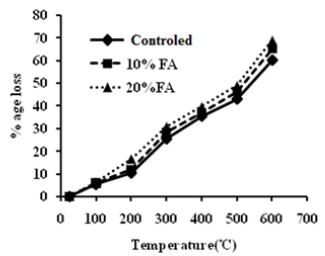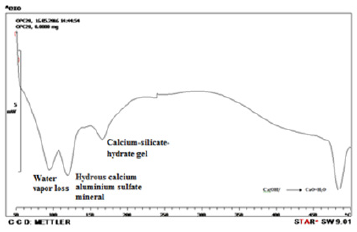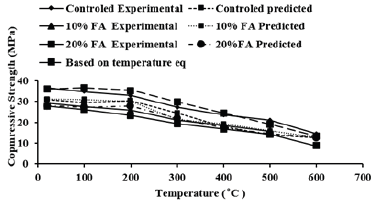- Submissions

Full Text
COJ Technical & Scientific Research
Experimental Study on Fly Ash Concrete at High Temperature
Syed KAZ1*, Ram S2 and Bhupendra J2
1Civil Engineering Section, Aligarh Muslim University, India
2School of Engineering, Gautam Buddha University, India
*Corresponding author: Syed Kaleem Afrough Zaidi, Civil Engineering Section, Aligarh Muslim University, Aligarh, India
Submission: July 20, 2021; Published: August 31, 2021

Volume3 Issue4August, 2021
Abstract
Concretes containing mineral admixtures are used extensively throughout the world for their good performance and the effects of high temperatures on such concrete are also due on its behaviors. Therefore an experimental study has been done to study the compressive behavior, physicochemical qualities of concrete exposed to high temperatures. The investigations were directed on ordinary Portland cement concrete cubes supplemented with 10% and 20% fly ash by weight of concrete. The cubes were along these lines presented to hoisted temperature in furnace under temperature scope of 100-600 °C and tried previously, then after the fact heating by ultrasonic testing and direct compression testing. The cubes tests were checked under differential calorimeter for watching the progressions under various lifted temperature. The result indicates that there is a drastic reduction in compressive strength occurred at temperature beyond 400 °C and higher losses were occurred with increase amount of fly ash in concrete.
Keywords: Fly ash; Concrete; High temperature; Physicochemical; Furnace; Ultrasonic testing; Mineral admixtures; Mechanical residual properties; Durability properties
Introduction
In the recent past there has been enormous increase in the usage of mineral admixtures in concrete and now it becomes one of the ingredients of concrete (Hossain and Lachemi, 2003). Therefore considerable attention has been given to the use of fly ash particularly as a partial replacement for cement in the production of normal strength concrete to high strength concrete. The structures made up of concrete containing fly ash as an admixture are often exposed to elevated temperature during fire [1]. It is therefore important to understand the behavior of concrete under such conditions for the safe design of structures. This paper presents an experimental study of normal strength concrete with characteristic compressive strength of about 30MPa, after exposed to 20 °C, 100 °C, 200 °C, 300 °C, 400 °C, 500 °C, and 600 °C according to the residual test method for study the mechanical properties of ordinary concrete . The residual compressive strength and the ultrasonic pulse velocity of concrete at different replacement of fly ash were measured. The behavior of concrete has been extensively investigated by many researchers under different testing conditions as well as with different proportions of the constituents. Sarshar & Khoury [2] tested OPC-PFA paste containing 30% fly ash by weight at different temperatures up to 650 °C. The residual compressive strength of fly ash concrete was reported to be 88% at 450 °C and 73% at 600 °C. Ghosh & Nasser [3] studied the effects of temperature between 21-232 °C and pressure varying from 5.2 to 13.8MPa on the strength of high strength concrete containing 20% and 60% of fly ash and in addition of 10% silica fume by weight of the total binder. A uniformed reduction in the compressive strength was observed with increasing temperatures. Xu [4] also studied the effects of fly ash replacement with binder ratio and curing conditions on the mechanical residual properties of concrete at high temperature. An increase in strength was observed at 250 °C.
The fly ash concrete showed better performance up to 650 °C than normal concrete. Poon [5] carried the study on strength and durability performance of normal and high strength concrete incorporating mineral admixtures like ,silica fume (5% and 10%), fly ash (20%, 30% and 40%), and blast furnace slag (30% and 40%) at elevated temperature up to 800 °C and exposed to one hour duration. It was found that concretes containing fly ash and blast furnace slag give the best performance particularly at temperatures below 600 °C as compared to others concrete. Raju & Rao [6] reported the influence of temperature varying from 100 to 250 °C on the residual compressive strength of concrete with partial replacement of cement by fly ash varying from 10% to 30%, and there is an increase in the residual compressive strength of concrete after 1, 2 and 3 hours of heating. Xu [5] investigated the mechanical and durability properties of pulverized fly ash concrete subjected to elevated temperature. They concluded that the addition of pulverized fly ash concrete improve the fire resistance properties of concrete.
Jia [7] present the results of the split tensile strength of high fly ash content concrete after exposure to high temperature. The specimens were prepared by the replacement of cement with fly ash with different percentages 30%, 40% and 50% by mass and were tested after exposure to high temperature varying from 250 to 650 °C. The results showed that the split tensile strength sensitivity decreased with the increase in temperature. Huai Shuai Shang [8] studied the properties of high-performance concrete with fly ash and the ultrasonic velocity at various temperatures such as 20, 100, 200, 300, 400 and 500 °C . They reported that thermal properties, at elevated temperatures, exhibited by high-performance concrete are similar to those of plain concrete. Khan MS [9] they studied the behavior of high volume fly ash concrete at varying peak temperatures on replacing the cement with fly ash in the range of 40-60% by weight. The compressive and split tensile strength of concrete increased initially with an increase in the temperature up to 300 °C, however, further the increase in the exposure temperature caused reduction in both the strength. The loss of weight of the concrete increased with increase in the temperature as well as the fly ash content. Larissa Kirchhof D [10] study the relationship between UPV residual data and compressive strength of concrete with different mixture proportion with water-cement ratio of 0.25, 0.30 and 0.50.
The specimen were heated in an electric furnace at temperatures ranging from 200 °C to 600 °C. There is a reduction in compressive strength as well in the UPV results for both NSC and HSC samples due to the increase of porosity/permeability in fire-damaged concrete. It is seen that despite extensive research on the topic however the detailed knowledge of the effect of high temperature on concrete is still lacking. This study examines the residual compressive strength and ultrasonic pulse velocity of fly ash concrete after exposure to elevated temperatures ranging from room, 100 °C to 600 °C. Now a days nondestructive testing methods are mostly employed for determining the physical properties of concrete, therefore a relationship between residual compressive strength and the ultrasonic pulse velocity propagation was established to determine the residual compressive strength of concrete exposed to elevated temperature. The quality of concrete on the bases of UPV values at ambient temperature are well established as excellent, good, doubtful, poor and very poor for 4500m/s and above, (3500 to 4500), (3000 to 3500), (2000 to 3000)and 2000m/s and below UPV values, respectively. Several experimental studies had been carried out to investigate the quality of concrete by using the value of UPV both at ambient and exposed to elevated temperature. Further some authors have been developing the relation between the ultrasonic pulse velocity and the compressive strength of concrete at high temperature. In this study a relationship between the residual strength ratio and the residual UPV ratio was also studied and discuss.
Experimental Details
Materials
In this study, the Portland Cement 43 grade, the coarse and fine aggregates with nominal well graded sizes of 20mm and 4.5mm, were used respectively. A super plasticizer was also used for specimens, to achieve the required workability of concrete mixes for fly ash concrete.
Mix proportions
The study has been performed on 3 mixtures, one of controlled concrete and another two with partial replacement of 10% and 20% fly ash with cement. The mix pro portions and materials properties are surmised in (Table 1) and (Table 2) respectively.
Table 1: Design mix (Kg/m3).

Table 2: Materials properties.

Sample preparation and experimental test details
For each batch, 21 cube specimens (150mmx150mmx150mm) were cast and de-mould 24 hours later after casting and placed in a water tank at room temperature for 28 days. After the curing periods finished, the samples were placed in an electronic furnace and heated at different temperature 100 °C, 200 °C, 300 °C, 400 °C, 500 °C and 600 °C. Each temperature was maintained for 3 hours to achieve the thermal steady state. The heating rate was set at 10 °C/min and the specimens were allowed to cool naturally to room temperature in furnace. Then after for the residual mechanical properties tests and NDT tests was conduct according with relevant Indian codes. For measuring the of residual compressive strength of all specimens a UTM of loading capacity is 2000kN were used as shown in (Figure 1). For each test, the result represents the average of three cube specimens of concrete. The results were comparing with references values at ambient temperature (unheated concrete specimens).
Figure 1: Universal testing machine.

Result and Discussion
The variation of properties in concrete exposed to elevated temperatures depend on many factors such as constituent materials, initial strength, age of concrete, water content, methods of thermal testing etc. However, there is no doubt that when concrete is exposed to elevated temperature or fire, there is a significant reduction of compressive strength of concrete. It is shown in (Figure 2) that as the temperature increases from room temperature the compressive strength of concrete gets reduces in a gradual manner. However, the residual compressive strengths are more pronounce in all specimens between 400 °C and 600 ºC. From the (Figure 2) it is also evident that the compressive strength of concrete decrease with the increase in temperature and the percentage loss of compressive strength ranges from zero to 60.10% for control concrete, however the losses are , 5.3% at 100 °C, 10.35% at 200 °C, 25.42% at 300 °C, 35.43% at 400 °C, 42.96% at 500 °C, 60.10% at 600 °C. The percentage losses in 10%replacement of fly ash concrete specimens are 5.3% at 100 °C , 10.35% at 200 °C, 25.42% at 300 °C, 35.43% at 400 °C, 42.96% at 500 °C, 60.10% at 600 °C and similar trends were observed for 20% replacement of fly-ash concrete were 6.3% at 100 °C, 16.46% at 200 °C, 30.80% at 300 °C, 39.62% at 400 °C, 48.92% at 500 °C, 68.89% at 600 °C respectively. The (Figure 3) shows the comparison between ultrasonic pulse velocity and the expose temperature, for three different mixture proportions of concrete.
Figure 2: UPV at different temperatures.

Figure 3: Percentage loss in residual compressive strength at different temperatures.

From the results it was observe that there is a reduction in ultrasonic pulse velocity values as the temperature increase from room temperature. Therefore the residual compressive strength of concrete also reduces in as all specimens. This behavior has been expecting since a rapid temperature increase causes significant changes in porosity and permeability of concrete due to release of absorbed water, dehydration of C-S-H and, probably, formation of micro and macro-cracks. All these processes lead to an increase in the connectivity of pores network [11]. The UPV results may be attributed due to increase in pores, cracks or voids will cause an increase in the time of wave propagation through the specimens, and therefore resulting in lower ultrasonic pulse velocities. From the test result of UPV on conventional concrete the velocity decreases from 4.75 to 0.23km/sec as the temperature increases from ambient room to 600 °C, however the fall is drastic for samples above 400 °C from 3.6 to 0.23km/sec. The variation in observed value of UPV for 10% fly ash and 20% Fly ash specimens were from 4.6 to 0.3km/sec and 3.0 to 0.28km/sec for the temperature above 400 °C. This indicate due to the transformations and loss of cements like portlandite. A study is also be carried out on DSC for replacement of fly ash at 10% and 20% and at typical DSC were presented in (Figure 4). It seen from (Figure 4), the bend and crests of misfortune are higher in traditional cement than cement with fly ash and the different peaks are identified (a) First downfall peak is due to the free moisture loss present in it below 100 °C, (b) Second downfall peak is due to ettringite loss below 200 °C, (c) Third downfall peak is due to CSH dehydration below 200 °C, and Fourth downfall peak is due to the decomposition of portlandite around 500 °C.
Figure 4: Relative UPV and strength ratio.

Weight loss after heating
The weight loss from all three concrete mixes increased with the increase in the maximum exposed temperatures due to accelerated drying however at a temperature of 100 °C, concrete specimen lost between 1.7 and 2.6 % of their initial weights. This was mainly due to the evaporation of free water. In order to verify this fact, two cylinders each of each concrete mix were exposed to a temperature of 75 °C for a prolonged period when the temperature was increased to 200 °C, the maximum losses occurred for the exposure duration of 12hrs, and the weight losses were 6.8%, 6.2% and 5% respectively for 40, 80 and 100MPa mixes. When the temperature was increased to 400 °C, the maximum losses occurred for the exposure duration of 8hrs, and the corresponding weight losses were 7.6%, 7.4% and 5.7% respectively for 40, 80 and 100MPa mixes. The increased weight losses are probably due to the dehydration of the hydration products and the loss of water from the fine pores in the cement paste and aggregate particles. From the results of UPV values at different temperature of all the mixes, it is seen that at the temperature of 200 °C and 300 °C the UPV values are 4650, 4600, 4200m/s in all the three mixes, however at the temperature of 400 °C and 500 °C the UPV values are 800, 1500 and 1000m/s in all the three mixes respectively. The residual strength of concrete is classified as excellent quality of concrete up to 300 °C but at 600 °C, the pulse velocity decrease and there is a very significant reduction in values like 230, 300 and 280m/s in all the mixes which can be classified as poor quality of concrete. The (Figure 2) also explain the as the temperature increase the concrete specimens degraded from ‘‘excellent’’ to ‘‘good’’, to ‘‘doubtful’’, to ‘‘poor’’ respectively. The UPV values decreased more when the cement is replaced with 20% at all expose temperature. The relative UPV and relative residual compressive strength are plotted in (Figure 4) for all the mixes. From the figures it was observed that the behaviour of all the mixes are same at all exposed temperature (Figure 5).
Figure 5: DSC curve of cube sample with 20% fly ash.

Physical observations of concrete cubes
In this experimental examination cubes were heated from 100 °C to 600 °C with a temperature gap of 100 °C for 3hrs. In the wake of giving introduction their physical recognition is done which incorporates breaking on the surface of cube.
Spallings
When concrete is expose to high temperature spalling in concrete has been reported by many authors [12,13] however no such spalling were found up to 60 °C in all specimens’ in the present study.
Colour change
Before the mechanical testing the colors of exposed concrete specimens was observed, according to the visual inspections the variation in the color is observed with respect to exposed temperature. In general at 300 °C the concrete color does not change, however as the temperature increased the color changes, and its light gray and pink when the concrete is exposed to temperature at 400 °C and between 500 °C to 600 °C [14-16].
Cracks pattern
According to the visual inspection of surface crack, no visible cracks were found in temperature range 100 °C to 300 °C for all the mixes however normal visible cracks were seen in concrete with 20% fly ash subjected to 400 °C, and these cracks were more pronounced when concrete subjected to 500 °C and 600 °C . The cracks shaped at 400 °C were not very many in number and scattered however between 500 °C and 600 °C some cracks were notice and the cracks framed at 600 °C or more were unmistakable and firmly pressed and interlinked.
Residual compressive strength and UPV values
It is evident from the literature that there is not any standard correlation between the UPV and the concrete compressive strength at elevated temperature because the residual strength of concrete is influenced by many factors. In literature the compressive strength of concrete and pulse velocity values are describe by a non-liner model in the general form of

Therefore, in this study from experimental results a regression analysis between the average of ultrasonic pulse velocity (vc) in m/s and the compression values (fc) in MPa were performed and the equation (1) has been modified

Where fc is the residual compressive strength, vc=pulse velocity (m/s) a and b are constants.
Further a co-relation between exposed temperature and residual compressive strength of concrete is developed for fly ash concrete

Where f/c compressive strength of concrete at ambient condition. The (Figure 6) shows the relationship between residual compressive strength and exposed temperature for fly ash concrete. In this study experimental and predicted results are compared . These results indicated that a relatively good correlation between the residual strength based on UPV values and also gives the best fitted for this relationship [17,18].
Figure 6: The relationship between residual compressive strength and exposed temperature based on proposed equations.

Conclusion
With the present lab facility a series of tests were performs to study the evaluate the residual compressive strength and ultrasonic pulse velocity of concrete subject to high temperatures with replacement of fly ash with cement. Based on the experimental results, the following conclusions are drawn. The mix proportion has a significant role on the residual compressive strength of concrete subjected to high temperatures and there is a continuous reduction in residual compressive strength of concrete in all specimens. Drastic loss in compressive strength was occurred at temperature beyond 400 °C, because complete decomposition of portlandite and variation of thermal expansion between coarse aggregate and cement mortar. Higher percentage loss of compressive strength was noticed in more amount of fly ash in concrete samples i.e., for 20% fly ash concrete. The Pulse velocity reduced quite rapidly at temperatures 300 °C after 28 days curing and falls below 1km/sec for temperatures beyond 500 °C. The reduction in pulse velocity is due to loss of free, capillary and bound water evaporation and dehydration on heating. A relationship between the residual compressive strength and UPV ratios have been established to estimate the residual compressive strength of fire-damaged concrete with the measured residual UPV. The ultrasonic pulse velocity test is found to be an effective tool to assess the degree of damage in concrete structures exposed to high temperatures. An exponential relationship between UPV and compressive strength for the different concrete mix has provided an adequate approximation for comparing them with the experimental results.
References
- Chan YN, Peng GF, Anson M (1999) Residual strength and pore structure of high-strength concrete and normal strength concrete after exposure to high temperatures. Cement and Concrete Composites 21(1): 23-27.
- Sarshar R, Khoury GA (1993) Material and environmental factors influencing the compressive strength of unsealed cement past and concrete at high temperatures. Magazine of Concrete Research 45(162): 51-61.
- Ghosh S, Nasser KW (1996) Effects of high temperature and pressure on strength and elasticity of lignite fly ash and silica fume concrete. ACI Material Journal 93(1): 51-60.
- Xu Y, Wong YL, Poon CS, Anson M (2003) Influence of PFA on cracking of concrete and cement paste after exposure to high temperatures. Cement and Concrete Research 33(12): 2009-2016.
- Xu Y, Wong YL, Poon CS, Anson M (2001) Impact of high temperature on PFA concrete. Cement and Concrete Research 31(7): 1065-107
- Raju PM, Rao JA (2001) Effect of temperature on residual compressive strength of fly ash concrete. The Indian Concrete Journal, pp. 347-351.
- Jia FP, Cheng Y, Sun YB, Wang YY, Sun H (2011) Study on residual splitting tensile strength of HFCC after high temperature. Advanced Materials Research 5: 243-
- Huai-Shuai S, Ting-Hua Y (2013) Behavior of HPC with fly ash after elevated temperature. Advances in Materials Science and Engineering, pp. 1-7.
- Khan MS, Abbas H (2015) Effect of elevated temperature on the behavior of high volume fly ash concrete. KSCE Journal of Civil Engineering 19(6): 1825-1831.
- Larissa DK, Alexandre L, Luiz CP (2015) Assessment of concrete residual strength at high temperatures using ultrasonic pulse velocity. The e-Journal of Nondestructive Testing 20(7): 1-9.
- Izabela H, Helene C (2007) Ultrasonic pulse velocity investigation on concrete subjected to high temperature with the use of cylindrical and exponential transducer. In: Fontana A, Frangi M, Knobloch M (Eds.), 7th International Conference on Structures in Fire, Switzerland, pp. 805-814.
- Zaidi KA, Sharma UK, Bhargava P, Bhandari NM (2012) Effect of elevated temperature on residual compressive stress-strain behaviour of unconfined concrete. Journal of Structural Fire Engineering 3(4): 327-350.
- Ramesh KV, Raju DM, Rekha K (2016) A study on high volume fly ash concrete exposed to elevated temperatures. American Journal of Engineering Research 5(11): 227-238.
- Belaribi H, Mellas M, Rahmani F (2016) The relationship between the compressive strength and ultrasonic pulse velocity concrete with fibers exposed to high temperatures. Third International Conference on Energy, Materials, Applied Energetics and Pollution ICEMAEP 2016, Algeria, pp. 158-164.
- Khaliq W, Venkatesh K (2012) High temperature mechanical properties of high strength fly ash concrete with and without fibers. ACI Materials Journal 109(6): 665-674.
- IS: 516 (1959) Indian Standard Code of Practice- Methods of test for strength of concrete. Bureau of Indian Standards (BIS), India, pp. 1-30.
- Poon CS, Azhar S, Anson M, Wong YL (2001) Comparison of the strength and durability performance of normal and high-strength pozzolanic concretes at elevated temperatures. Cement and Concrete Research 31(9): 1291-1300.
- Cruz Hernández RA, Zapata Orduz LE, Quintero Ortiz LA, Herrera Ortiz JO (2015) Physical and mechanical characterization of concrete exposed to elevated temperatures by using ultrasonic pulse velocity. Revista Facultad de Ingeniería Universidad de Antioquia 75: 118-129.
© 2021 Syed KAZ. This is an open access article distributed under the terms of the Creative Commons Attribution License , which permits unrestricted use, distribution, and build upon your work non-commercially.
 a Creative Commons Attribution 4.0 International License. Based on a work at www.crimsonpublishers.com.
Best viewed in
a Creative Commons Attribution 4.0 International License. Based on a work at www.crimsonpublishers.com.
Best viewed in 







.jpg)






























 Editorial Board Registrations
Editorial Board Registrations Submit your Article
Submit your Article Refer a Friend
Refer a Friend Advertise With Us
Advertise With Us
.jpg)






.jpg)














.bmp)
.jpg)
.png)
.jpg)










.jpg)






.png)

.png)



.png)






